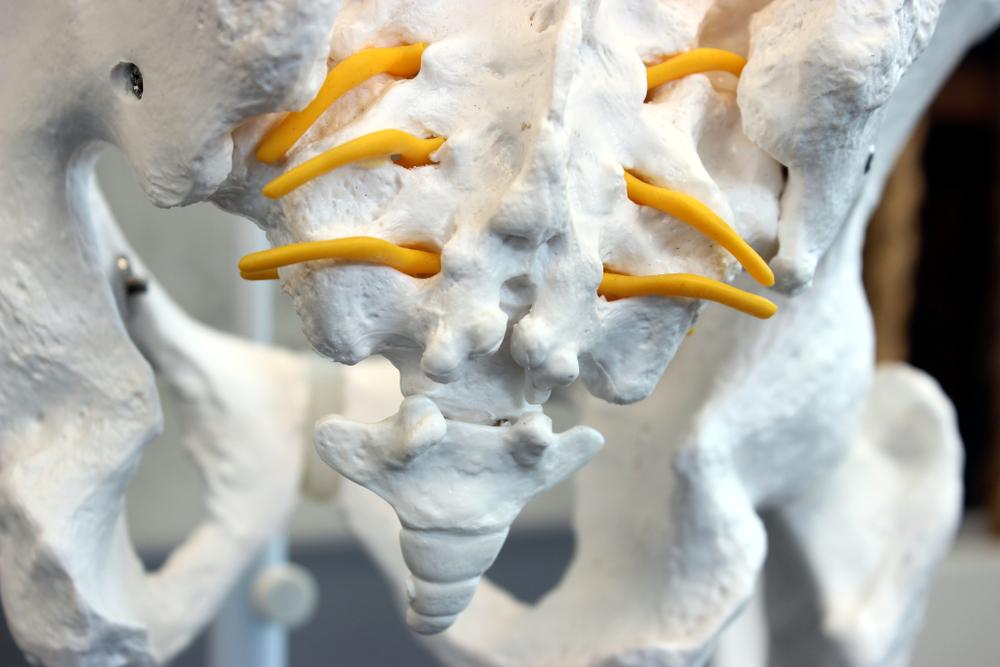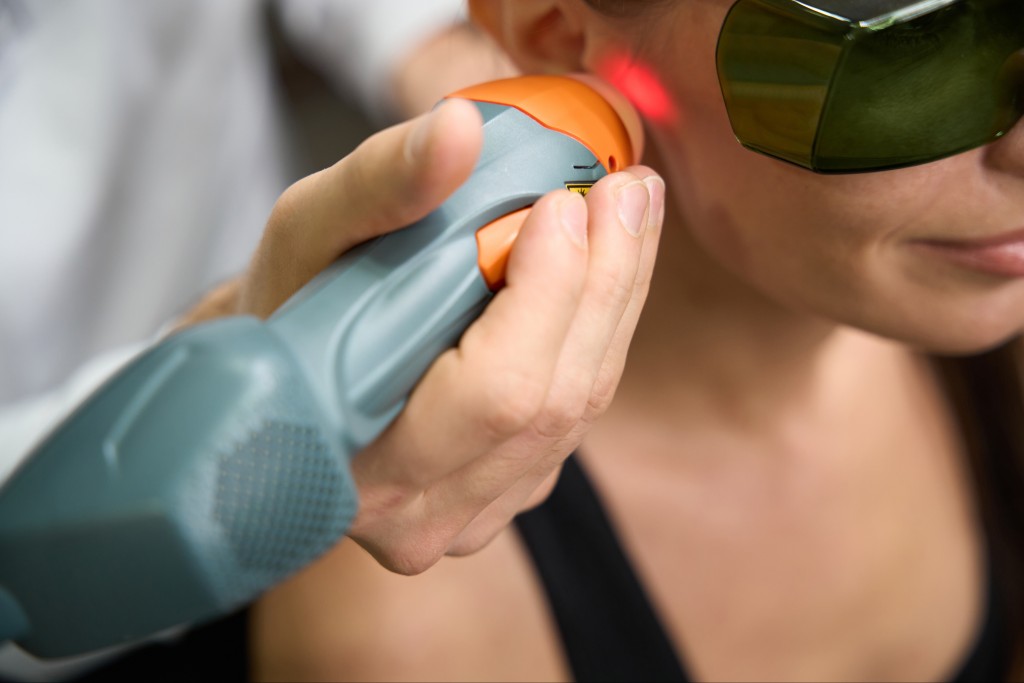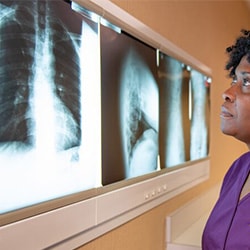
The sacrum is a triangular-shaped flat bone that sits like an upside-down heart at the base of your spine. It is located between the hips. It also connects to the pelvis and helps stabilize the body when sitting, standing, or walking. It might not be one of the first bones that come to mind when you think of a break, or it may not seem like a big deal if you do suffer a sacral fracture. In fact, between 25% to 70% of all sacral fractures can be misdiagnosed or go undiagnosed altogether. The sacrum is a strong, dense bone that is difficult to break.
A sacral fracture is often the cause of either aging and bone deterioration or trauma such as a car accident. While sacral fractures are not as common as lumbar spine, pelvic, or coccyx fractures, they can still occur and can also be quite painful, and if not diagnosed, can lead to long-term effects and further complications.
Types of Sacral Fractures
Car accidents or sports injuries are the most common causes of sacral fractures.
Osteoporosis or other underlying conditions may also be the root of a sacrum fracture. There are a few different types of sacral fractures that can occur.
Low impact fractures
These types of fractures, also known as insufficiency fractures, are the kind that typically occur in the elderly that have weak bones or other conditions such as osteoporosis. In these cases, a person may have slipped or fallen on their tailbone and will experience persistent buttocks or back pain. The pain is usually described as an achy feeling in the hips, lower back, and buttocks.
High-energy sacral fractures
These types of fractures are often a result of trauma such as a car accident or a fall from high up. They can also occur in conjunction with pelvic or spinal fractures, especially in the event of a motor vehicle collision. About 50% of all high-energy sacral fractures also result in nerve injuries in the lowest segments of the spinal cord.
Stress fractures
Too much activity, such as continued long-distance running, can lead to stress fractures of the sacrum. Women who have just had a baby may also experience a sacral stress fracture. The activity is usually too much for the sacrum to withstand and will lead to a stress fracture. If you experience lower back, buttocks, or leg pain when running, this could be a sign of a sacral stress fracture and may require rest from such activities to fully heal. When beginning to run again, start slowly in order to avoid a recurrence of the same injury.
Symptoms of a Sacral Fracture
A sacral fracture can show up through various symptoms, often becoming noticeable when doing everyday activities like sitting or standing. Recognizing these symptoms early is crucial for timely medical intervention and effective treatment. Here are some of the most common symptoms of a sacral fracture:
- Pain and Discomfort: The most immediate and noticeable symptom of a sacral fracture is pain. You may experience severe discomfort, especially when placing weight on the sacrum, such as while sitting, standing, or moving from a sitting to a standing position. You may also experience pain throughout the hips and lower back, making everyday activities challenging.
- Bruising and Discoloration: Bruising or discoloration around the lower back and buttocks is another common symptom. This can develop from trauma to the tissues and blood vessels surrounding the sacrum. The bruising might not appear immediately and could develop over several days.
- Inflammation and Swelling: Inflammation and swelling in the lower back and pelvic region can also be a sign of a sacral fracture. The body’s natural response to injury is to increase blood flow to the affected area, leading to swelling and tenderness. This can also make your pain worse and further limit mobility.
- Muscle Weakness: Muscle weakness, particularly in the lower back, hips, and legs, may occur with a sacral fracture. This weakness can result from both the pain and the body’s effort to protect the injured area, leading to reduced physical activity and subsequent muscle atrophy.
Delayed Onset of Symptoms
It’s important to note that symptoms of a sacral fracture may not always be immediate. In some cases, it could take days or even weeks for symptoms to show up. This delay can occur due to the body’s initial shock response or minimal activity levels that do not stress the fractured area.
Importance of Prompt Medical Attention
Because symptoms of a sacral fracture can appear differently for each person, it’s important to see a doctor as soon as you notice any signs. Getting an early diagnosis and treatment can help prevent more problems and start you on the right path to recovery. The sooner you begin broken sacrum treatment you can accelerate a sacrum fracture recovery time. Ignoring symptoms or waiting to get medical help can result in the long-term effects of a fractured sacrum.
Diagnosing a Sacral Fracture
Diagnosing a sacral fracture can be difficult as they don’t always show up on an x-ray. They can be misdiagnosed as a sprained back, lower back fracture, or a urinary tract infection. When pain doesn’t improve over time, it could mean something else is actually at the root of the problem. A CAT scan or MRI is more effective at showing a sacral fracture for proper diagnosis.
In fact, after performing an initial examination to determine symptoms and discussing a patient’s health history, the next step in properly diagnosing a sacral fracture is ordering imaging. Doctors are then able to take a close look at these images to diagnose your injury and move forward with a personalized treatment plan that will aid in your recovery.
When it comes to an untreated sacral fracture, the long-term effects of a fractured sacrum can include the following:
- Stiff muscles that cause limping
- Assistance required going up and down stairs
- Help getting in and out of bed
- Walking aids to move around
- Nerve damage and numbness
- Soft tissue damage
Call your doctor if you notice swelling or experience pain in the back, buttocks, and legs that don’t go away, have pain that gets worse when you walk but better when you lie down, or have questions about your condition. Seek immediate care if you have increased pain in the lower back region, experience numbness or weakness of the legs, have a tingling sensation like pins and needles in the legs, or experience problems controlling your bladder or bowel movements.
Treatment and Recovery After a Sacral Fracture
Recovering from sacral fractures primarily involves time and rest, allowing the bone to heal naturally. However, your doctor might suggest additional treatment methods to expedite the sacral fracture healing time and ensure a successful recovery.
Extra support
Immediately following the injury, additional support may be necessary to support the healing process. Your doctor may recommend a back brace to stabilize the bone and prevent any movement that could disrupt the healing process. These supportive devices help keep the bone in place as it fuses back together.
Restricted movement
Limiting physical activity is also important for proper healing. While complete bed rest is not advisable, it’s important to avoid intense activities and excessive movements. Activities that involve twisting, bending, or jumping should be avoided to prevent further aggravation of the injury. You may also want to try sacroiliitis sleeping positions to help you sleep with SI pain.
Heat and Cold Therapy
Applying heat or cold packs to the affected area can help manage pain and reduce swelling. Cold therapy is typically used in the first 48 hours after the injury to reduce inflammation, while heat therapy can be applied later to relax muscles and improve blood flow to the area.
Pain Medication
To manage the pain associated with a sacral fracture, doctors often prescribe pain medications. Anti-inflammatory medications may be taken to reduce swelling and inflammation around the injury site. These medications can help reduce pressure on the legs and joints and make the recovery process more comfortable.
Physical Therapy
While rest is essential, incorporating physical therapy into the recovery plan is also important for the healing process. Once the initial healing phase is complete, doctors may recommend physical therapy to improve mobility and strengthen the body. Tailored exercises and routines help restore normal function and prevent long-term issues.
Surgery
In some cases, surgery may be necessary, especially if the fracture takes longer than expected to heal. A minimally invasive surgical procedure known as sacroplasty might be performed by an orthopedic surgeon. Recovery from sacroplasty can take several months, but it is often successful in promoting healing and reducing discomfort.
Follow Your Doctor’s Recommendations
Regardless of the treatment plan prescribed, it’s crucial to follow your doctor’s recommendations closely, even after you start feeling better. Sticking to the treatment plan ensures the best chance of a full recovery and minimizes the risk of complications or re-injury.
Preventing Sacral Fractures
Not all sacral fractures can be prevented, especially high-energy sacral fractures that are the result of an accident such as a car crash or slip and fall injury. But you can do a lot to strengthen your sacrum bone so that it is more equipped to withstand an injury or won’t be as prone to weakness and degeneration as you get older.
One thing you can do is eat a calcium-rich diet. Calcium is great for bone strength. If you aren’t getting enough calcium in your diet, you can also take calcium and vitamin D supplements to ensure your bones are receiving the calcium they need to stay strong. Weight-bearing exercises are also a great support for your body.
Strong muscles are able to better support the musculoskeletal system. Other tips for avoiding potential sacral fractures can include using proper equipment and techniques in sporting activities or removing any tripping hazards, such as rugs or clutter on the floor, to prevent potential falls and injuries.
Experienced Accident Doctors at AICA in Atlanta
Suffering from an injury can be a painful and traumatic experience, especially if it is the result of an accident. Sacrum fractures are already hard enough to diagnose and painful to deal with. To make sure you receive an accurate diagnosis and quality care throughout the recovery process, you will want to work with an experienced accident doctor who is familiar with these types of injuries.
Qualified professionals at AICA in Atlanta are here for you. From using imaging to properly diagnose your sacral fracture to working with a variety of specialists to form a comprehensive treatment plan, our team of doctors will see that you receive the highest level of care and the best chance for a full recovery after an injury. Improper care is a very real risk to your health, especially when it comes to the potential long-term effects that could come from a lack of treatment for a fractured sacrum. Our orthopedists, radiologists, pain management doctors, neurologists, physical therapists, chiropractors, or other specialists can help manage long-term effects to alleviate pain and help you find relief.
A fractured sacrum doesn’t have to affect your quality of life. Get back to living your life with the help of medical professionals at AICA Atlanta. Contact us today for more information about our services or to schedule your appointment.








